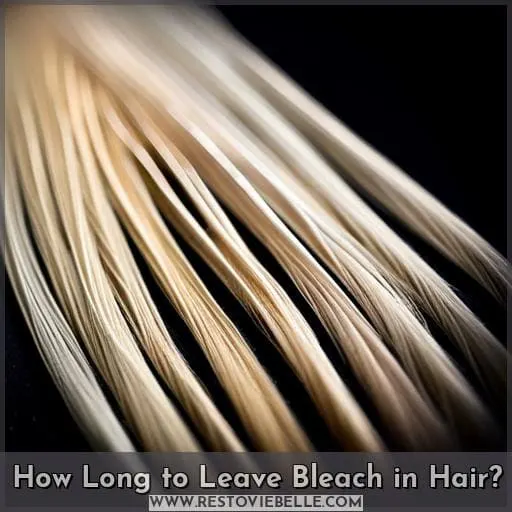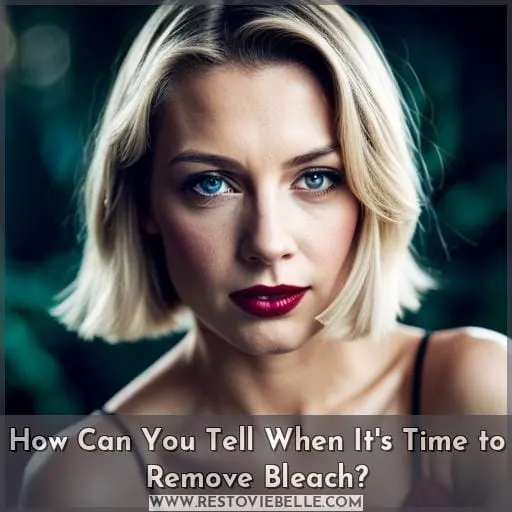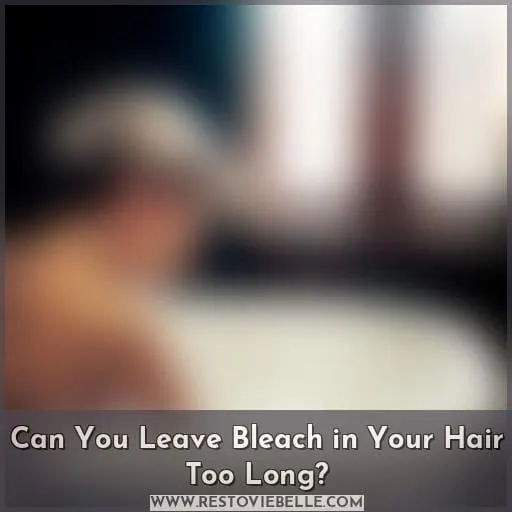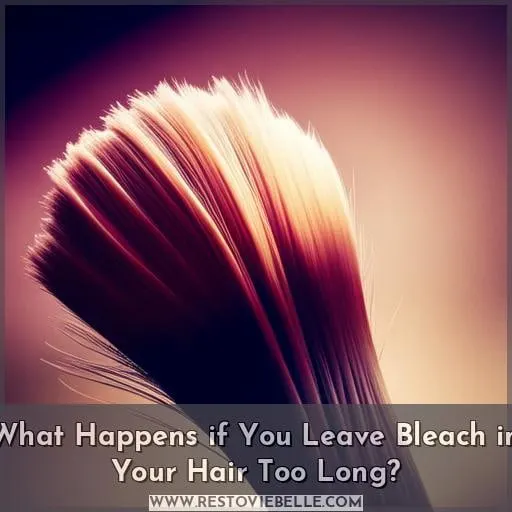This site is supported by our readers. We may earn a commission, at no cost to you, if you purchase through links.
 Dreaming of lightening up your locks? You’re not alone. Many people turn to bleach to give them that perfect shade, but one key question stands in the way: How long do you need to leave it on for?
Dreaming of lightening up your locks? You’re not alone. Many people turn to bleach to give them that perfect shade, but one key question stands in the way: How long do you need to leave it on for?
The answer depends on a number of factors such as hair type and color, as well as how dark you want it. Typically, leaving bleach in your hair for 15-30 minutes should be enough time—but going over this limit can lead to irreversible damage.
If you’ve left the bleach too long or just want some post-bleaching tips then read on! We’ll cover everything from telling when it’s time remove the product all the way through taking care of your colored mane after bleaching so that you get those beautiful results without any damage done!
Table Of Contents
- Key Takeaways
- How Long to Leave Bleach in Hair?
- How Can You Tell When It’s Time to Remove Bleach?
- Can You Leave Bleach in Your Hair Too Long?
- What Happens if You Leave Bleach in Your Hair Too Long?
- What Should You Do if You Left Bleach in Your Hair for Too Long?
- Best Ways to Take Care of Your Hair Post-Bleaching
- Common Mistakes to Avoid When Bleaching Your Hair at Home
- Conclusion
Key Takeaways
- Determine bleach duration based on factors such as hair type, texture, and color.
- Dark hair may need up to 30 minutes of bleach, while blonde hair requires 15-20 minutes.
- Avoid leaving bleach on for more than 30 minutes.
- Check the lightness of your hair every 5-10 minutes during the bleaching process.
How Long to Leave Bleach in Hair?
If you’re considering bleaching your hair, it’s important to know how long to leave the bleach in. Timing is key for achieving the desired shade without damaging your hair. Knowing when and how long to leave bleach in can help you achieve salon-quality results at home.
Factors to Consider Before Bleaching Your Hair
Before bleaching your hair, consider factors such as type, texture, and color to ensure you get the best results. For example, dark hair requires up to 30 minutes of bleach application, while blonde hair needs 15-20 minutes.
To prevent damage and achieve desired results, do a strand test before bleaching. Use quality bleach products and apply bleach to the mid-shaft and ends first. Follow product directions carefully and have protective gear on hand.
Post-bleaching care is also important. Oil treatments, deep conditioning, and sun protection can all help restore moisture retention in weakened strands.
Effects of Leaving Bleach for Too Long
If you fail to monitor the bleaching process carefully, your hair may be exposed to damaging levels of oxidizing agents and suffer from irreversible damage. Overexposure can lead to hair turning white or orange, breakage and split ends, as well as keratin loss resulting in brittle strands.
To avoid these mistakes, take note of factors like type, thickness, color, and texture when deciding bleach duration; the maximum application time should not exceed 30 minutes. Additionally, restore moisture after treatment with oil treatments or deep conditioning while maintaining a healthy diet for the best results in avoiding further damage.
Precautions
Take extra care when bleaching your hair at home, as overexposure to bleach can cause serious damage. A pre-bleach test is essential for gauging results and timing the process correctly.
Factors such as hair type, color, texture, and thickness all affect bleach duration.
Additionally, consider post-bleach treatments like deep conditioning and oiling to restore lost keratin levels in order to keep your locks healthy after bleaching them.
Lastly, but most importantly, keep an eye on time: don’t leave the bleach in longer than 30 minutes – otherwise, you may end up with white or brittle hair!
How Can You Tell When It’s Time to Remove Bleach?
Knowing when it’s time to remove the bleach from your hair can be tricky, but there are a few indicators that can help guide you. Firstly, it’s essential to check the lightness level of your hair every 5-10 minutes during bleaching.
This will allow you to monitor the progress and avoid overexposure signs such as brittle or unmanageable locks.
Secondly, consider factors like your hair type (coarse vs fine), thickness, and texture. These factors play a role in determining the duration of the bleach. Coarse strands may need up to 30 minutes, while blonde hair may require only 15-20 minutes.
Thirdly, strand tests are valuable in providing information about the effects of the bleach so far. They allow you to make necessary adjustments if needed before removing the bleach completely. To remove the bleach, use warm water followed by oil treatments or deep conditioning to restore the health of your hair after the bleaching process.
Finally, it’s important to use protective gear throughout and always follow the product directions carefully when using powerful chemicals at home. This way, you’ll minimize potential risks associated with DIY bleaching sessions.
Can You Leave Bleach in Your Hair Too Long?
Be aware that overexposure to bleach can lead to irreversible damage, so it’s important to monitor the bleaching process closely. Hair type, thickness, color, and texture all play a role in determining bleach duration.
Strand tests are valuable for gauging the effects of bleach on your particular strands and should be carried out regularly throughout the process.
If not properly processed, dark hair can turn orange, so it’s crucial to avoid leaving bleach on black locks for more than 30-45 minutes. Leaving it on for too long can strip away all coloring, resulting in white or brittle hairs.
Post-bleaching care is essential. Consider oil treatments, deep conditioning, and avoiding heat styling.
What Happens if You Leave Bleach in Your Hair Too Long?
Beware: leaving bleach on too long can cause serious damage to your locks! Hair exposed to overexposure of bleach will become brittle and unmanageable. Factors such as hair type, thickness, color, and texture all play a role in determining how long the bleaching process should take.
For example, coarse hair may need up to 30 minutes, while dark or fine hair both require 30 minutes for an optimal result. Strand tests are also useful for gauging what duration would be best suited given individual circumstances.
Correcting mistakes like this requires professional advice from a stylist, along with treatments like oil therapies and deep conditioning that help restore the post-bleaching health of the damaged tresses.
Adhering strictly to product instructions is essential when prepping at home as well; if not followed correctly, then results could end up being disastrously orange instead of a blonde bombshell!
What Should You Do if You Left Bleach in Your Hair for Too Long?
If you’ve left bleach in your hair for too long, don’t worry! There are ways to revive and restore its health. Overexposure to bleach can damage the hair’s cuticles and weaken its strength, so it’s important to take corrective measures quickly.
To minimize further damage, consider post-bleaching care such as oil treatments or deep conditioning. These treatments will help bring moisture back into the strands. Avoid using heat styling tools after bleaching, as they can cause more harm than good.
In addition to these treatments, maintaining a healthy diet with plenty of protein can aid in the recovery of over-bleached hair.
To prevent these issues in future bleaching sessions, always perform strand tests beforehand. This will give you an accurate gauge of how long each section of hair needs to be exposed to the bleach before rinsing it off completely.
It’s also important not to mix different types of chemicals when bleaching your hair. Mixing chemicals can cause adverse reactions and may require a longer processing time, which can lead to more trouble if forgotten about.
Best Ways to Take Care of Your Hair Post-Bleaching
Now that you’ve bleached your hair, it’s time to move onto the next step: post-bleaching care. To maintain optimal hair health and color protection, make sure to take proper measures for restoring moisture levels.
This includes regular oil treatments as well as deep conditioning masks or products specifically designed for bleached hair.
Avoid heat styling if possible; if necessary, use a heat protectant before applying any hot tools such as curling irons or blow dryers. Diet plays an important role too: incorporate essential vitamins and minerals to help keep your scalp healthy while providing nourishment from the inside out for stronger locks overall.
With these tips in mind, following a dedicated post-bleaching maintenance routine will ensure long-lasting results without sacrificing quality of life!
Common Mistakes to Avoid When Bleaching Your Hair at Home
Be mindful of common bleaching mistakes when attempting to lighten your hair at home, such as skipping strand tests or using the wrong products – all easy-to-avoid missteps that can help you achieve your desired results without compromising on quality.
Take precautions when DIYing; read instructions carefully and use protective gear. Never apply bleach for more than thirty minutes and monitor progress regularly to avoid white hair.
Common mistakes include not washing prior to bleaching (which is recommended) and mistaking peroxide-free labels for safety (oxidizing agents may still be present).
Choose between wet and dry application depending on desired result color change goals.
Wait three days before using purple shampoo after bleaching dark hair to avoid overcorrecting with brassiness from the shampoo.
Avoid double damage by abstaining from dry shampoo usage while trying out new colors.
Taking these steps will prevent potential damage like weakened strands or Keratin loss, leading to brittle and unmanageable locks.
Conclusion
Bleaching your hair at home can be a great way to save money and achieve a lighter shade, but it’s important to know how long to leave bleach in your hair. The length of time you should leave the bleach in depends on factors such as the thickness and color of your hair, the bleach being used, and the desired outcome.
Generally, it’s best to leave bleach on for no longer than 30 minutes. However, during the process, it’s crucial to check the lightness of your hair every 5-10 minutes. Leaving bleach in for too long can cause hair to turn white, become brittle, and lose its porosity.
After bleaching, it’s important to take good care of your hair. This includes using oil treatments, deep conditioning, and sun protection. By properly preparing and understanding the process, you can safely bleach your hair at home.












